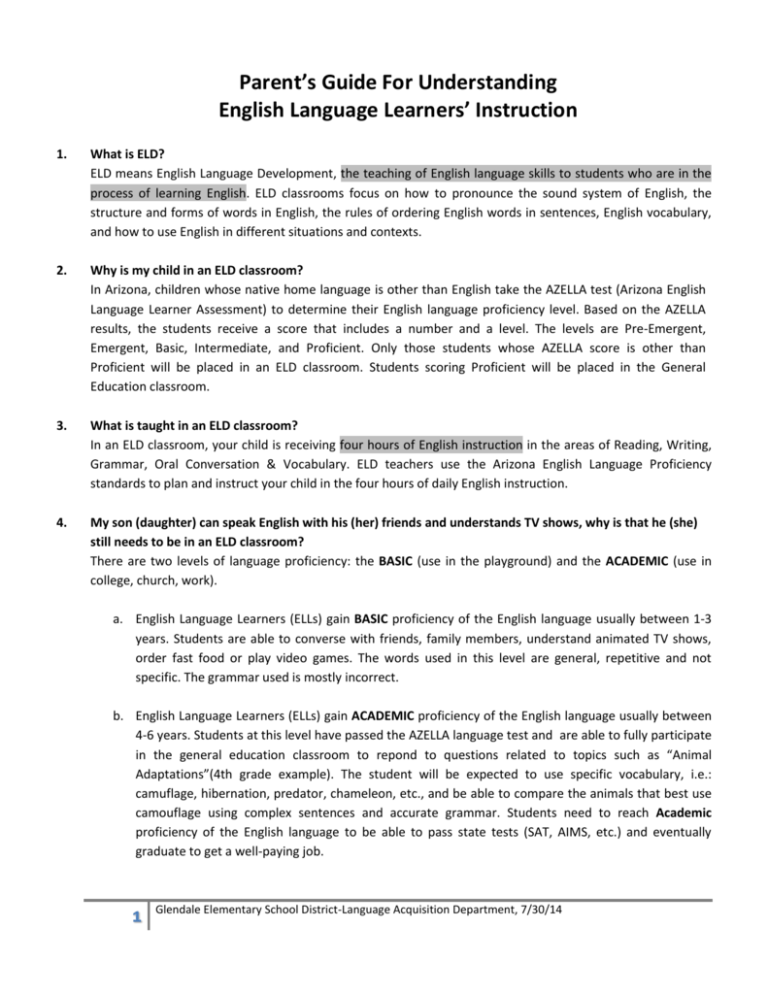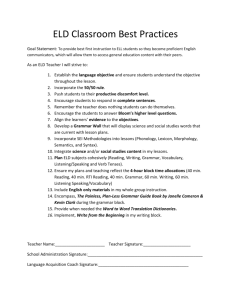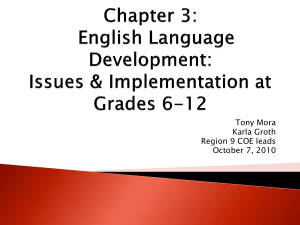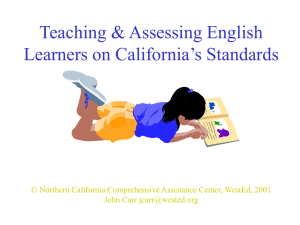Understanding ELL Instruction-English
advertisement

Parent’s Guide For Understanding English Language Learners’ Instruction 1. What is ELD? ELD means English Language Development, the teaching of English language skills to students who are in the process of learning English. ELD classrooms focus on how to pronounce the sound system of English, the structure and forms of words in English, the rules of ordering English words in sentences, English vocabulary, and how to use English in different situations and contexts. 2. Why is my child in an ELD classroom? In Arizona, children whose native home language is other than English take the AZELLA test (Arizona English Language Learner Assessment) to determine their English language proficiency level. Based on the AZELLA results, the students receive a score that includes a number and a level. The levels are Pre-Emergent, Emergent, Basic, Intermediate, and Proficient. Only those students whose AZELLA score is other than Proficient will be placed in an ELD classroom. Students scoring Proficient will be placed in the General Education classroom. 3. What is taught in an ELD classroom? In an ELD classroom, your child is receiving four hours of English instruction in the areas of Reading, Writing, Grammar, Oral Conversation & Vocabulary. ELD teachers use the Arizona English Language Proficiency standards to plan and instruct your child in the four hours of daily English instruction. 4. My son (daughter) can speak English with his (her) friends and understands TV shows, why is that he (she) still needs to be in an ELD classroom? There are two levels of language proficiency: the BASIC (use in the playground) and the ACADEMIC (use in college, church, work). a. English Language Learners (ELLs) gain BASIC proficiency of the English language usually between 1-3 years. Students are able to converse with friends, family members, understand animated TV shows, order fast food or play video games. The words used in this level are general, repetitive and not specific. The grammar used is mostly incorrect. b. English Language Learners (ELLs) gain ACADEMIC proficiency of the English language usually between 4-6 years. Students at this level have passed the AZELLA language test and are able to fully participate in the general education classroom to repond to questions related to topics such as “Animal Adaptations”(4th grade example). The student will be expected to use specific vocabulary, i.e.: camuflage, hibernation, predator, chameleon, etc., and be able to compare the animals that best use camouflage using complex sentences and accurate grammar. Students need to reach Academic proficiency of the English language to be able to pass state tests (SAT, AIMS, etc.) and eventually graduate to get a well-paying job. 1 Glendale Elementary School District-Language Acquisition Department, 7/30/14 5. How long should my child be in an ELD classroom? English Language Learners (ELLs) take between four to six years to learn English. Once your child scores Proficient on the AZELLA, your child will be able to read, write, speak, and comprehend class work and homework in a General Education classroom. 6. How is an ELD classroom different from a general education classroom? An ELD classroom is a transitional class where your child learns English. It is different from the general education classroom, in that the content taught emphasizes the teaching of the English language itself. Because Language is the content, your child will not have a Science and Social Studies period in their classroom, but will receive language instruction in Grammar and Oral Conversation related to Science and Social Studies topics or themes. The general education classroom requires that your student passes the AZELLA test to demonstrate that the student is proficiency in the English language at the Academic level. 7. What type of training do teachers (instructing in the ELD classroom) receive? Teachers instructing in the ELD classroom receive every school year an average of 35-40 hours of specialized training to effectively teach the English language to ELLs through the four content areas of ELD. Additionally, the teachers are supported and monitored by a team of expert trainers. 8. How could I support my child to acquire proficiency in English? Studies conducted in homes of children who are learning English have shown that when parents read with their children, take their children on trips to the library, monitor homework, communicate with the teacher, and show a genuine interest in their child’s progress-their children learn English quicker than children whose parents do not. In some homes where parents did not speak English, progress was still made by the student because reading and writing skills in any language are helpful to children learning those same skills in English. 2 Glendale Elementary School District-Language Acquisition Department, 7/30/14






